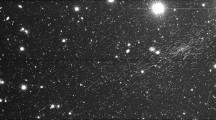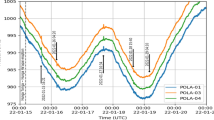Abstract
The nature of ultrahigh-energy cosmic rays (UHECRs) at energies >1020 eV remains a mystery1. They are likely to be of extragalactic origin, but should be absorbed within ∼50 Mpc through interactions with the cosmic microwave background. As there are no sufficiently powerful accelerators within this distance from the Galaxy, explanations for UHECRs range from unusual astrophysical sources to exotic string physics2. Also unclear is whether UHECRs consist of protons, heavy nuclei, neutrinos or γ-rays. To resolve these questions, larger detectors with higher duty cycles and which combine multiple detection techniques3 are needed. Radio emission from UHECRs, on the other hand, is unaffected by attenuation, has a high duty cycle, gives calorimetric measurements and provides high directional accuracy. Here we report the detection of radio flashes from cosmic-ray air showers using low-cost digital radio receivers. We show that the radiation can be understood in terms of the geosynchrotron effect4,5,6,7,8. Our results show that it should be possible to determine the nature and composition of UHECRs with combined radio and particle detectors, and to detect the ultrahigh-energy neutrinos expected from flavour mixing9,10.
This is a preview of subscription content, access via your institution
Access options
Subscribe to this journal
Receive 51 print issues and online access
$199.00 per year
only $3.90 per issue
Buy this article
- Purchase on Springer Link
- Instant access to full article PDF
Prices may be subject to local taxes which are calculated during checkout


Similar content being viewed by others
References
Nagano, M. & Watson, A. A. Observations and implications of the ultrahigh-energy cosmic rays. Rev. Mod. Phys. 72, 689–732 (2000)
Sigl, G. The enigma of the highest energy particles of nature. Ann. Phys. 303, 117–141 (2003)
Haungs, A., Rebel, H. & Roth, M. Energy spectrum and mass composition of high-energy cosmic rays. Rep. Prog. Phys. 66, 1145–1206 (2003)
Falcke, H. & Gorham, P. W. Detecting radio emission from cosmic ray air showers and neutrinos with a digital radio telescope. Astropart. Phys. 19, 477–494 (2003)
Huege, T. & Falcke, H. Radio emission from cosmic ray air showers. Monte Carlo simulations. Astron. Astrophys. 430, 779–798 (2005)
Huege, T. & Falcke, H. Radio emission from cosmic ray air showers: simulation results and parametrization. Astropart. Phys. (submitted); preprint at http://arxiv.org/astro-ph/0501580 (2005)
Huege, T. & Falcke, H. Radio emission from cosmic ray air showers. Coherent geosynchrotron radiation. Astron. Astrophys. 412, 19–34 (2003)
Suprun, D. A., Gorham, P. W. & Rosner, J. L. Synchrotron radiation at radio frequencies from cosmic ray air showers. Astropart. Phys. 20, 157–168 (2003)
Capelle, K. S., Cronin, J. W., Parente, G. & Zas, E. On the detection of ultra high energy neutrinos with the Auger observatory. Astropart. Phys. 8, 321–328 (1998)
Bertou, X., Billoir, P., Deligny, O., Lachaud, C. & Letessier-Selvon, A. Tau neutrinos in the Auger Observatory: a new window to UHECR sources. Astropart. Phys. 17, 183–193 (2002)
Askaryan, G. A. Excess negative charge of an electron-photon shower and its coherent radio emission. Sov. Phys. JETP 14, 441–443 (1962)
Saltzberg, D. et al. Observation of the Askaryan effect: Coherent microwave Cherenkov emission from charge asymmetry in high-energy particle cascades. Phys. Rev. Lett. 86, 2802–2805 (2001)
Zas, E., Halzen, F. & Stanev, T. Electromagnetic pulses from high-energy showers: Implications for neutrino detection. Phys. Rev. D 45, 362–376 (1992)
Jelley, J. V. et al. Radio pulses from extensive cosmic-ray air showers. Nature 205, 327–328 (1965)
Allan, H. R. Radio emission from extensive air showers. Prog. Element. Part. Cosmic Ray Phys. 10, 169–302 (1971)
Antoni, T. et al. The cosmic-ray experiment KASCADE. Nucl. Instrum. Methods A 513, 490–510 (2003)
Horneffer, A. et al. LOPES: Detecting radio emission from cosmic ray air showers. Proc. SPIE 5500, 129–138 (2004)
Ravel, O. et al. Radio detection of cosmic ray air showers by the CODALEMA experiment. Nucl. Instrum. Methods Phys. A 518, 213–215 (2004)
Antoni, T. et al. A non-parametric approach to infer the energy spectrum and the mass composition of cosmic rays. Astropart. Phys. 16, 245–263 (2002)
Gousset, T., Ravel, O. & Roy, C. Are vertical cosmic rays the most suitable to radio detection? Astropart. Phys. 22, 103–107 (2004)
Acknowledgements
A.F.B. is on leave of absence from the National Institute of Physics and Nuclear Engineering, Bucharest; T.H. is now at the Institut für Kernphysik, Forschungszentrum Karlsruhe, Karlsruhe; S. Ostapchenko is on leave of absence from Moscow State University, Moscow. LOPES was supported by the German Federal Ministry of Education and Research (Verbundforschung Astroteilchenphysik). This work is part of the research programme of the Stichting voor Fundamenteel Onderzoek der Materie (FOM), which is financially supported by the Nederlandse Organisatie voor Wetenschappelijk Onderzoek (NWO). The KASCADE experiment is supported by the German Federal Ministry of Education and Research. The Polish group is supported by KBN; the Romanian group acknowledge support from the Romanian Ministry of Education and Research.
Author information
Authors and Affiliations
Corresponding author
Ethics declarations
Competing interests
Reprints and permissions information is available at npg.nature.com/reprintsandpermissions. The authors declare no competing financial interests.
Supplementary information
Supplementary Figure S1
Layout of the LOPES and KASCADE array. (DOC 93 kb)
Supplementary Figure S2
Radio pulse as a function of time. (DOC 264 kb)
Supplementary Figure S3
Dependence of radio signal on geomagnetic angle. (DOC 53 kb)
Supplementary Video S1
Time lapsed video of the radio emission of an air shower. (MPG 314 kb)
Supplementary Video S1 Legend
Legend to accompany the above Supplementary Video. (DOC 23 kb)
Rights and permissions
About this article
Cite this article
Falcke, H., Apel, W., Badea, A. et al. Detection and imaging of atmospheric radio flashes from cosmic ray air showers. Nature 435, 313–316 (2005). https://doi.org/10.1038/nature03614
Received:
Accepted:
Issue Date:
DOI: https://doi.org/10.1038/nature03614
This article is cited by
-
The Muon Puzzle in cosmic-ray induced air showers and its connection to the Large Hadron Collider
Astrophysics and Space Science (2022)
-
Coherent emission mechanisms in astrophysical plasmas
Reviews of Modern Plasma Physics (2017)
-
A large light-mass component of cosmic rays at 1017–1017.5 electronvolts from radio observations
Nature (2016)
Comments
By submitting a comment you agree to abide by our Terms and Community Guidelines. If you find something abusive or that does not comply with our terms or guidelines please flag it as inappropriate.



